
What is App Store Optimization & Why is ASO Important?
Are you new to App Store Optimization? If you have just decided to start optimizing your app(s) and you’re a bit overwhelmed, don’t worry! In this guide, you’ll find everything you need to know about ASO, app store ranking signals, how ASO is different for the App Store and Google Play, and how to get started with ASO.
What is App Store Optimization (ASO)?
Defining App Store Optimization
The apps we want to download from the App Store or Google Play are more visible when they rank highly in search results for a variety of keywords, maintain a high position in the top charts, or get featured on the store. But how do you make sure your app is put in front of the right people, in the right places? And how do you make sure these people actually download your app? That’s where ASO comes in.
We define App Store Optimization (ASO) as the process of improving an app’s visibility on the app stores and maximizing its appeal to new, existing, and lapsed users with the objective of increasing app downloads and (re)activations.
In simpler words, ASO comes down to this simple equation: traffic multiplied by conversion equals downloads.
Keyword optimization vs conversion rate optimization
ASO focuses mostly on two pillars:
- Keyword optimization: Keyword optimization involves researching, analyzing, and selecting the right keywords to include in your app’s title, subtitle, keyword field, and long description.
- Conversion rate optimization: Conversion rate optimization is the systematic process of adjusting the textual and visual elements of your app’s product page to ensure that a higher percentage of users download the app after seeing it.
These two pillars work closely together – a solid keyword optimization strategy will result in higher rankings, while great conversion rate optimization procedures will make sure that increased visibility leads to more app downloads.
The basics of ASO
There are a lot of factors that can impact your app’s visibility and organic downloads (more on this later) and, as a result, an ASO expert’s job is very diverse. Depending on a company’s priorities, goals, and KPIs, ASO can consist of:
- Executing keyword research to optimize app metadata with the most searched for keywords.
- Optimizing app creative assets such as icons, screenshots, and videos to encourage more users to download your app.
- Localizing an app’s product page to foreign languages worldwide.
- Implementing an effective review strategy to ensure a steady stream of positive reviews.
- Increasing an app’s visibility in editorial content, featured stories, or “Similar Apps” placements.
- Monitoring app store changes and competitor updates to maintain app visibility.
ASO vs SEO
App Store Optimization, or ASO, is often referred to as mobile SEO or SEO for apps. This analogy comes in pretty handy when understanding the overall principle of ASO. But the app stores and the web are two very different ecosystems, hence there are quite some differences between ASO and SEO.
- Search intent: Search queries in the app stores are generally shorter than on the web. People tend to search for specific apps by their brand name or are looking for new apps that can serve an exact need. When searching the web, people often seek answers to specific questions or they make queries about buying a certain product or service. Therefore, search queries tend to be longer.
- Keywords: In the app stores, keyword optimization is limited to the app title, subtitle, and keyword field or long description. Therefore, app marketers need to carefully select a handful of relevant keywords to increase their visibility. On the web, conversely, it is possible to optimize different web pages for different search queries.
- Backlinks vs app downloads: Search engines rely on the amount and quality of backlinks to determine the authority of a website. App stores rely on app download velocity to assess authority. The more downloads an app receives over an amount of time, the higher the ranking chances of the app.
- Page speed vs uninstall rate or retention rate: Both search engines and app stores want to provide users with the best user experience. Search engines, therefore, prioritize websites with fast page speeds in the search results. On the other hand, app stores rely on user metrics such as uninstall rate or retention rate to feed their algorithm.
How do users search in the app stores?
According to Apple, most apps are discovered through app store searches (65%). AppTweak estimated that although brands only account for 24% of all keywords, branded keywords drive 49% of all App Store traffic. It’s interesting to note that the search from generic keywords still accounts for more than half of App Store traffic, although we tend to think that users mostly look for brands in the store.
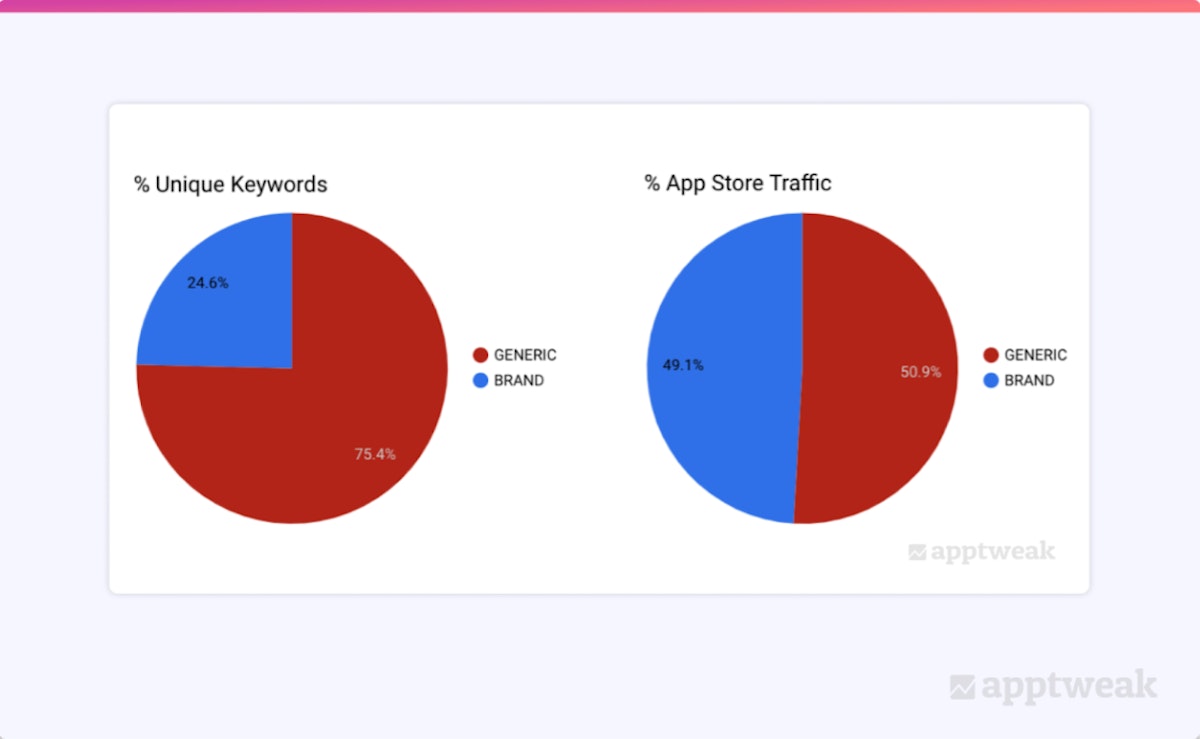 Comparing the percentage of unique keywords with a search popularity above 12 against the traffic they drive (US App Store).
Comparing the percentage of unique keywords with a search popularity above 12 against the traffic they drive (US App Store).
It’s true that brands typically have higher search volumes than generic keywords. For example, in this graph below, we see that the proportion of branded keywords increases significantly as we look at keywords with higher volumes. This explains how 24% of keywords end up driving 49% of App Store traffic – these keywords represent a high concentration of the App Store’s high-volume search terms.
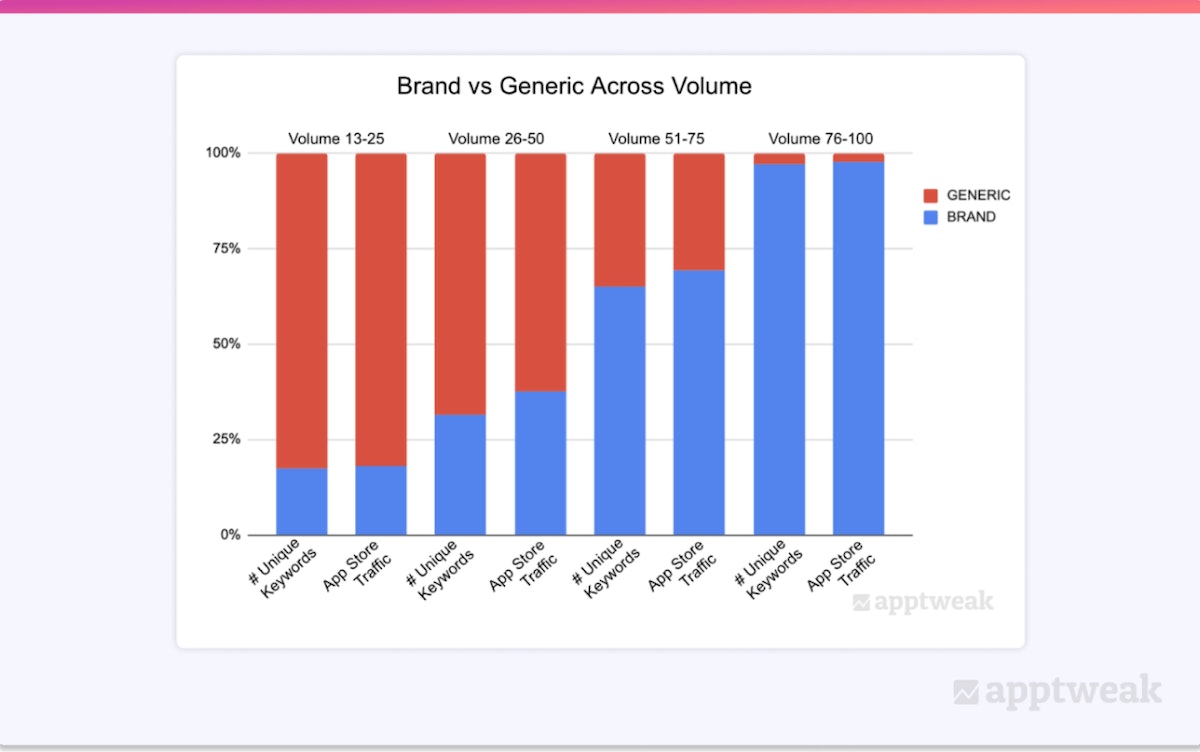 Distribution of brand vs generic keywords and the traffic they drive for a group of keywords with given volumes (US App Store).
Distribution of brand vs generic keywords and the traffic they drive for a group of keywords with given volumes (US App Store).
When it comes to App Store traffic, although high-volume keywords are mostly brands, there are many medium-volume keywords which, when strategically combined, represent a big portion of App Store traffic. In other words, generic keywords constitute a very long tail of App Store traffic. This is where you can make a difference – capturing the traffic from those generic keywords can really help to increase the overall downloads to your app.
Why is ASO important?
There is no question that App Store Optimization (ASO) should be part of every mobile marketer’s marketing stack, especially for the following reasons:
- Every single user eventually comes through the app store to download your app. Whether users land on your app page via search ads, social media ads, or native ads, your app page plays a major role in convincing these users to download your app. A well-optimized app page will lead to a higher conversion rate and lower cost per installs (CPIs) for your advertising campaigns.
- If you’re not investing in ASO, you’re missing out on the largest discovery channels available to your app: According to Apple, 65%of all downloads on the App Store happen after a keyword search. This means that working on your search optimization will put you in the best position to get your app in front of the people looking for it.
- Your team should be prioritizing ASO as a sustainable method to get your app in front of the right people. You might be hesitant about the effectiveness of ASO if your app has a strong brand, such as Spotify, Candy Crush, or Netflix, who probably get the majority of their downloads from people specifically searching for their brand name.
However, optimizing your use of generic keywords is a very effective way to gain new customers and further increase your brand awareness. For example, Tinder is one of the most popular dating apps in the world, and a significant proportion of the app’s installs consistently come from generic keywords, such as “dating apps,” “meet friends,” or “match.” - ASO also helps to increase your app’s chance of getting featured! With more than 2 million apps on the app stores, getting featured by Apple or Google is a very rare opportunity. However, the more you follow the store’s best practices and guidelines with a solid ASO strategy, the higher your chances are of being featured.
- Finally, your competitors are doing it! AppTweak data shows that over the last year in the US App Store, the top 30 apps in the Shopping category updated their icon almost 4 times, while the top 30 apps in the Casual (Games) category updated their icon more than 4.5 times. Apps in the Games (Casual) category updated their screenshots more than 9 times, while shopping apps carried out the most updates in terms of screenshots – 19 times.
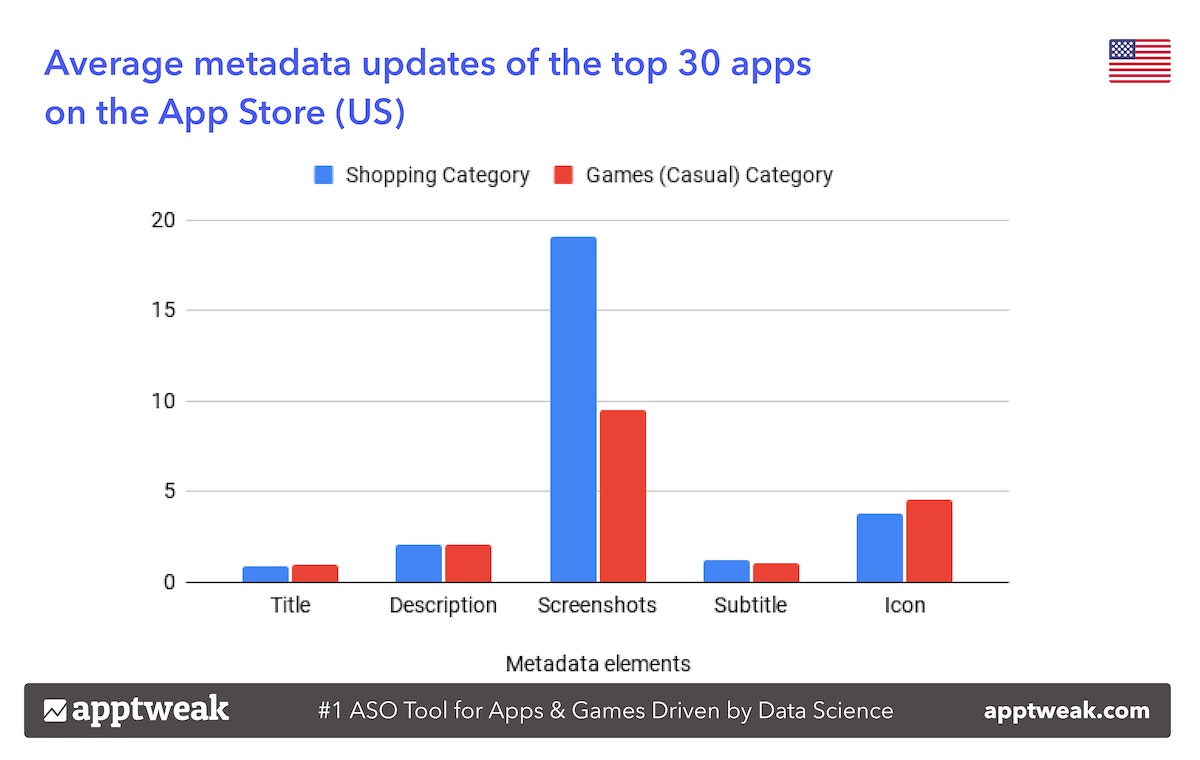 Average metadata updates of the top 30 apps in the Shopping category and Games (Casual) category in the US, App Store. Source:AppTweak
Average metadata updates of the top 30 apps in the Shopping category and Games (Casual) category in the US, App Store. Source:AppTweak
Increasing organic downloads by 454% with ASO
There is no question that when executed carefully, ASO can generate excellent results. This couldn’t be better demonstrated than the case study of Superscale, a growth platform for apps and games to help increase their visibility on the app stores and increase user acquisition.
When Superscale was tasked with growing the user base of Nimblebit’s Flagship game Tiny Tower, the platform first implemented a paid user acquisition strategy to increase downloads. However, the traffic and conversion results weren’t satisfying due to Tiny Tower’s outdated product page.
To optimize Tiny Tower’s app store page, SuperScale implemented an effective ASO strategy, focussing on both creative and keyword optimization. SuperScale relied on AppTweak’s ASO tool to perform diligent market and competitor research before updating Tiny Tower’s Google Play Store listing.
1. Improving app title and description
Superscale used AppTweak’s Keyword Research & Suggestion tools to identify relevant keywords to include in Tiny Tower’s metadata. Thanks to AppTweak’s extensive competition monitoring features, they could extend their research and easily spot missed opportunities and keyword gaps with competitors. This research was crucial to increasing Tiny Tower’s organic growth, in spite of its low category ranking.
2. Testing app icons and screenshots
After Tiny Tower’s title and descriptions were optimized, SuperScale turned to creative optimization. For this, SuperScale used AppTweak’s ASO Timeline feature to analyze competitors’ updates and A/B tests over time.
After spying on competitors’ data and creating new creative assets, SuperScale set up A/B to see how different screenshots, icons, and color palettes performed against the competition.
![]() Testing different icon variants of Tiny Tower.
Testing different icon variants of Tiny Tower.
As a result of implementing these ASO strategies with the support of AppTweak, the game’s conversion rate improved by 6.4% after completing a successful A/B test on Google Play. Downloads coming from search traffic increased by 25% in the weeks after the title and description update. Because of the investment in creative and keyword optimization, Tiny Tower was featured across the Play Store more often. As a result, downloads from Google Play Explore skyrocketed and grew more than 454%.
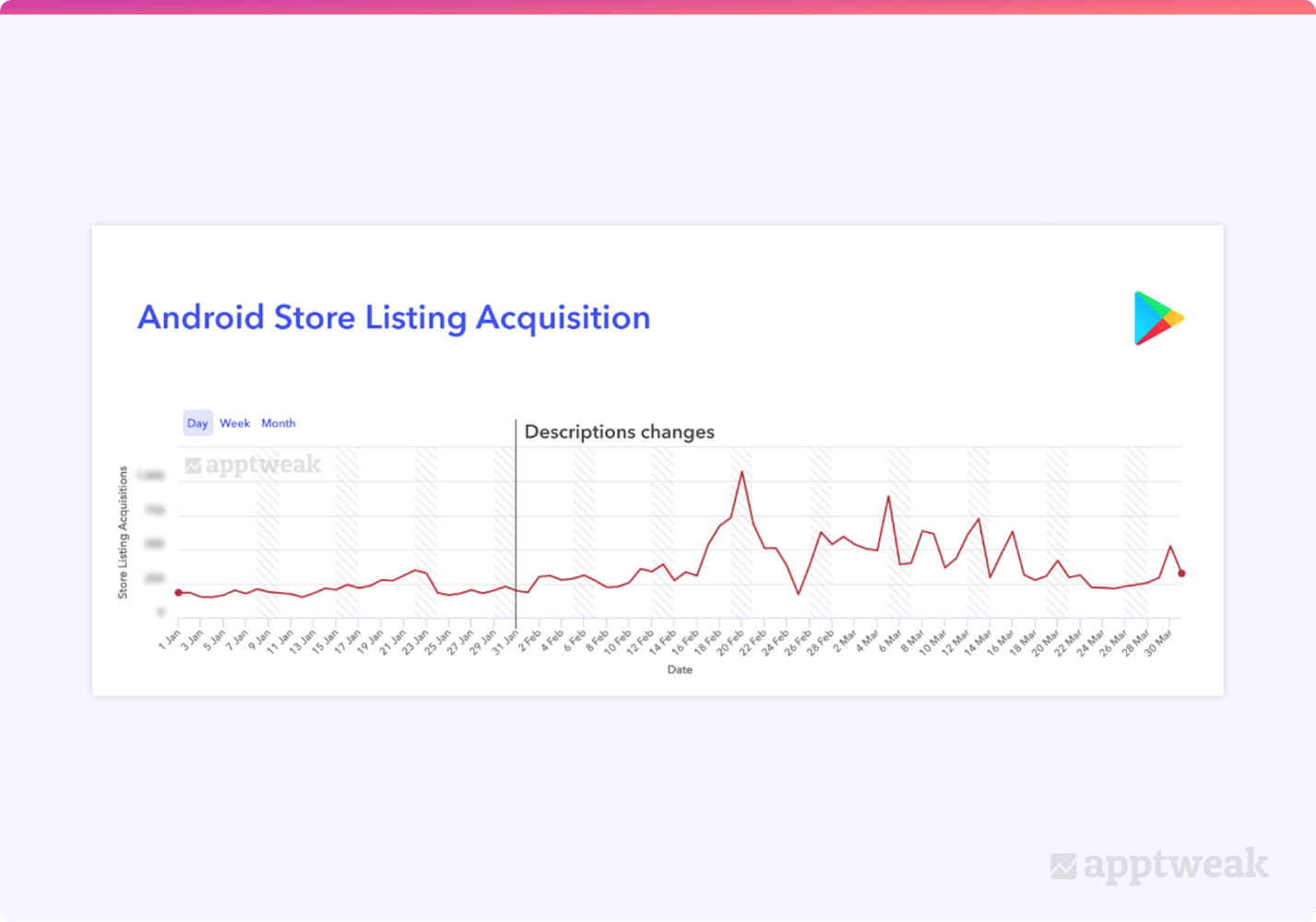
What are the ASO ranking factors?
To get started with App Store Optimization, you need to understand the app store algorithms. The App Store and Google Play have their own unique algorithm, but the main ranking signals are similar:
1. Keywords in app metadata
For app stores to decide whether to rank your app on a certain keyword, the algorithms look at the keywords provided in the app metadata (title, subtitle, and keyword field for iOS apps; title, short description, and long description for Android apps). If the keyword that users searched for has been added to your app’s metadata, your app has a chance to rank for that search term. The app store algorithm will further assign your app a higher rank if the keyword is contained in your app title, over the keyword field, or in the long description. As a general rule of thumb, keywords in the app title carry more weight than keywords in the subtitle, which, in turn, carry more weight than the iOS keyword field or long description.
Expert Tip
When looking at the live search results for the keyword “jigsaw puzzle” on Google Play, you can see that all the apps that rank have this keyword in their title. This suggests that apps that don’t have this keyword in their title have a lower chance to rank.
47b6.png) Live search results for the keyword “jigsaw puzzle” (US, Google Play).
Live search results for the keyword “jigsaw puzzle” (US, Google Play).
2. App download volume and velocity
The number of daily app downloads is one of the strongest ranking signals on both the App Store and Google Play. A high number of daily downloads will help increase your ranks on a wide variety of terms. The stores will consider an app that is driving a lot of daily downloads to be relevant to many store visitors’ interests. The number, velocity, and recentness of these downloads will play a big part in where you rank in the search results and top charts.
Apple & Google focus more specifically on download velocity, meaning that the app with the best ranking is not necessarily an older app that has accumulated a large number of downloads over time, but one that is being downloaded more every day.
3. App conversion rate
The algorithms also account for conversion rate (the share of people who download your app after seeing it in the search results). Both the App Store and Google Play want to provide users with a great user experience by showing the best possible apps in search results. If your app has a stable conversion rate for a specific keyword, it signals to the store that users are satisfied with the apps the algorithm is showing.
4. App ratings and reviews
The number of app reviews and your star rating represent another major ranking factor. As both stores only consider high-quality apps and games, they will consider an app’s ratings and reviews. Users are never keen to install an app with a rating below 4.0 stars, and given the intense competition on the app stores, even an app rated below 4.5 stars is at a disadvantage compared to higher-rated competition.
On the topic of quality, from February 2023, Google Play has set a minimum ratings bar of 3.0 stars to improve their top charts ranking. It is, therefore, important to encourage your users to leave reviews and ratings in order to increase your app’s weight on the algorithm.
Last but not the least, by fixing your app’s negative reviews, you will make your users happier and less likely to uninstall your app.
Discover interesting ratings insights with AppTweak’s Reviews and Ratings section
5. Retention rate
The stores do not solely rely on app downloads but also consider an app’s retention rate. If a lot of users uninstall your app shortly after it was downloaded, it signals to the algorithm that users were not happy with the app. Many argue that metrics such as session duration or the number of launches are also ranking signals.
6. App performance
If your app is not well built and crashes often, or consumes a lot of battery on users’ phones, the algorithms (especially for Google Play) will rank your app below others. Google announced on 2 November 2022 that it will replace the existing core vitals metrics with new, more user-focused metrics:
- Google has introduced a new bad behavior threshold that is evaluated per phone model (e.g. Pixel 6). At launch, this threshold will be set to 8%for both user-perceived crash rate and user-perceived ANR rate.
- If your app title exceeds the device bad behavior threshold on any core vital for a given phone model, Google Play may reduce the visibility of your title for users on that phone model.
- Android vitals will alert you of issues potentially associated with device hardware or software.
- A new side panel in Play Console provides consolidated device information, including install base, revenue, ratings and reviews.
- Maintain a minimum ratings bar of 3.0 star rating to increase your chances of being featured in the top charts.
7. Backlinks
The Google Play algorithm also looks at the number of backlinks your app’s webpage has received. Similar to SEO, the more backlinks, the higher your app’s authority. A high authority signals that your app is widely known and will result in a higher rank.
How is ASO different for the App Store and Google Play?
The App Store and Google Play have the same objective – to help users discover and download new apps. But both stores have a very different look and feel when it comes to app page and search results. Some of these differences have a major impact on how you should optimize your app.
47b6.png) An overview of Headspace’s app product page on the App Store vs Google Play.
An overview of Headspace’s app product page on the App Store vs Google Play.
Differences between App Store and Google Play search results
On the App Store search results:
- Apps appear alongside an app icon, title, subtitle, ratings, and screenshots.
- When the developer opts for portrait screenshots, 3 are shown in the search results. If landscape screenshots have been used, only 1 is shown in the search results. If the developer adds a portrait app preview video, the video will be placed before the first portrait screenshot and autoplay as users scroll down the search results page. Since the launch of iOS 15, screenshots won’t show in the search results for apps that users have already downloaded on their device.
- Apple allows titles of up to 30 characters, but in the search results, the title is usually cut off at 26 characters.
- Since the creative elements take up so much space, a maximum of 2 apps are shown on a phone screen. To see more, users have to scroll down. As a result, apps that are listed below the 10th position receive very little views.
The search results on Google Play look very different for branded or general searches.
47b6.png) Search results on the App Store (right) vs Google Play (left). On the App Store, the search results appear alongside the app name, subtitle, icon, and screenshots. On Google Play, the search results differ for generic vs branded searches.
Search results on the App Store (right) vs Google Play (left). On the App Store, the search results appear alongside the app name, subtitle, icon, and screenshots. On Google Play, the search results differ for generic vs branded searches.
- Up to 8 apps can be shown in the search results for a generic keyword.
- Apps appear with the app icon, title, developer name, ratings, and the average number of daily downloads.
- In contrast to the App Store, screenshots, videos, and the short description do not show in Google Play search results for generic keywords.
- Previously, Android titles were allowed to be up to 50 characters, but with the Google policy update in April 2021, app names are required to be only 30 characters, similar to the app title requirement in the App Store. Again, depending on the device, the title may be cut off in the search results.
- When searching for a branded keyword the search results look different. The corresponding app occupies most of the screen and appears with the app icon, title, developer name, ratings, downloads, screenshots, and short description. Underneath the app card, Google shows a carousel with “You might also like” and “Similar Apps”. Only below that (underneath the fold), you will find a list with apps that rank organically on this branded keyword.
To help users discover more apps, both stores include additional elements in the search results. On the App Store, you can find Editorial Collections, Stories, and in-app subscriptions. On Google Play, Google displays suggestion cards such as “You Might Also Like” or “Similar Apps.”
Get advanced insights about your app’s featurings with our improved Browse/Explore tool
| Apple | ||
|---|---|---|
| Banner or Featured Image | Only shows for certain apps at the top of the page. | There is no option to add a banner. |
| App Icon | Very visible at the top of the app page and in the search results. | Very visible at the top of the app page and in the search results. |
| App Title | 30 Characters – Shows next to the icon at the top of the app page and search results. | 30 Characters – Also shows next to the icon at the top of the app page and search results. |
| Developer Name | Shows underneath the app title on the app page, but automatically changes to display the subtitle after a few seconds. Also shows in the information panel on the app page. | Is clearly visible and shows underneath the app title in the search results and on the app page. |
| Subtitle or Short Description | 30 Characters – Shows underneath the app title in both the search results and app page and is usually cut off at 26 characters. | 80 Characters – Shows underneath the screenshots on the app page. When using portrait screenshots, the short description will usually be shown below the fold. |
| Information Panel | Displays total number of ratings and average star rating, age, place in the category, top charts, developer name, languages in which the app is available, and size. The information panel is displayed above the screenshots and users need to scroll through it horizontally to see all the info. | Displays total number of ratings and average star rating, total downloads, and age. The information panel appears above the install button and screenshots. |
| Screenshots | Either portrait or landscape screenshots can be added. Portrait screenshots take up most of the space and push down the first few lines of the long description below the fold. Up to 10 screenshots can be added in total. | Portrait screenshots display smaller and narrower in Google Play. Google does not have specific size requirements, but does recommend always adding at least 3 landscape screenshots so that the app is eligible to show in other places across the Play Store. Up to 8 screenshots can be added. |
| Video | Up to 3 preview videos can be added. Videos can be either in portrait or landscape mode and will be shown in the carousel before the screenshots on the app page and in the search results. | Only one promo video can be added to the store listing. The video will appear in the carousel before the screenshots on the app page. It is recommended to add a featured image, which will serve as overlay for the promo video. |
| Keyword Field | 100 Characters – The keyword field is not visible on the app page, but Apple does index the keywords added to the keyword field. | There is no option to add keywords in a keyword field for Android apps. |
| Long Description | 4,000 Characters – The first three lines are shown underneath the screenshots. To read the full descriptions, users have to click the “learn more” button. The keywords in the long description are not indexed in the App Store. | 4,000 Characters – No longer visible on the app page. Users need to click on the “arrow icon” next to the short description underneath “about this app” to read the long description. |
How differences between App Store and Google Play impact ASO
Search results, app pages, and the algorithms of the App Store and Google Play clearly look very different. These distinctions definitely impact how developers and mobile marketers should optimize their app store listings:
- The app name is a strong ranking signal on both the App Store and Google Play. But since the short description and screenshots are not shown for generic keywords in the Google Play search results, the app title plays a major role in expressing what your app is about and convince users to download your app over competitors’.
- The subtitles vary widely in length for the App Store vs Google Play (30 characters vs 80 characters respectively), and they also serve different purposes. In the App Store, the subtitle appears underneath the title in the search results; hence, it should explain to users what your app is about. For Android apps, the short description appears only on the app listing below the screenshots and should focus on grabbing the user’s attention while convincing them to download your app.
- Apple still relies on a 100-character keyword field to decide which keywords to rank your app for. Google does not have such a keyword field and looks at long-tail keywords added in the title, short description, and long description.
- The long description is an important ranking factor on Google Play, whereas keywords used in the long description don’t rank in the App Store. Therefore, mobile marketers should optimize their Google Play long description following SEO principles and increase the density of top-priority keywords. The long description in the App Store does not need to be written with keyword optimization in mind.
- Apple recommends not repeating keywords in the title, subtitle, and keyword field. Furthermore, it is advised to add single keywords to the keyword field (no long-tail keywords) because Apple will automatically make combinations between all the keywords used in the title, subtitle, and keyword field. Google’s algorithm is more advanced and applies standard SEO best practices in their algorithm. Therefore, mobile marketers should define their top single and long-tail keywords and increase the density of these keywords in their app page without running into the practice of keyword stuffing.
- App screenshots show up in App Store search results; but since iOS 15, screenshots don’t show anymore on the App Store if you have downloaded the app. In the Google Play results, screenshots show up for branded searches. It is recommended to add captions to your iOS screenshots that highlight your app’s main features or value proposition to make your app stand out in the search results. Furthermore, screenshots on the Android app page are smaller than screenshots on the iOS app page, hence it is advised to be very careful when adding captions on Google Play as they are harder to read.
- Google Play accounts for backlinks in their algorithm. Apple does not.
Learn more about the differences in ASO between the App Store and Google Play
How to get started with ASO
Now that you know all about App Store Optimization (ASO) ranking signals, the app store algorithms, and user search behavior, it’s time to get started and increase your organic downloads! Have a look at the tips below to discover what to focus on first.
Check this article out to craft an effective ASO strategy
1. Identify your competitors and analyze their ASO strategies
As a first step in your ASO strategy, identify which apps you are competing with and what their strategy is. When identifying your competition, you should not only consider direct competitors, but also apps or games competing for the same keywords in the app stores.
Before you start digging into keyword research, take a step back and have a look at what your competitors are doing in terms of ASO. Not only can you learn a lot from this exercise, it will also help you define realistic benchmarks or KPIs for your own strategy. An ASO tool like AppTweak can make this research a lot easier! With ASO Timeline feature, you can find out exactly when a competitor implemented a metadata update and see a before/after view of the update to see what has changed.
47b6.png) Screenshot of AppTweak’s ASO Timeline feature showing the before and after screenshots of Headspace in the US App Store.
Screenshot of AppTweak’s ASO Timeline feature showing the before and after screenshots of Headspace in the US App Store.
2. Audit your apps’ current metadata performance
Before you start optimizing different elements of your app page, you have to carefully audit your current performance. How is your current metadata performing? Is your app ranking on the keywords targeted in the app title or subtitle? Do these keywords drive volume and downloads to your app? This part of your research will make sure you don’t remove any keywords that are driving downloads to your app, while replacing those keywords for which you lack visibility.
With AppTweak’s Ranked Keywords feature, you can see all the keywords for which your app ranks. Powerful metrics such as “volume” help you understand how often this keyword is searched for. The “installs” metric shows an estimation of how many downloads each of these keywords brings to your app.
47b6.png) Screenshot of AppTweak’s Keyword Analysis feature showing valuable metrics such as “volume,” “rank,” and “installs” to help assess the performance of each keyword.
Screenshot of AppTweak’s Keyword Analysis feature showing valuable metrics such as “volume,” “rank,” and “installs” to help assess the performance of each keyword.
3. Find relevant keywords for your app
Now, let’s start with keyword research. To maximize your app’s visibility in the app stores, it is important you understand which keywords are used when your product/service is searched for in the app stores. Start with creating a list of 150–200 keywords that are all relevant to your app. This is what we call a brainstorm list. To build a good brainstorm list, you need to think wide: what keywords are potentially related to your app? Check the competition, put yourself in your users’ shoes, and think out of the box in order to find a broad range of relevant keywords. It’s also important to include long-tail keywords in there.
Another good idea is to list all the main features or benefits of your app. You can also scan the pages of competitor apps to find out which keywords they are targeting in their title or subtitle. But to truly find unique keyword opportunities (high-volume keywords for which your competitors lack visibility), it is best to invest in an ASO tool. AppTweak has more than 11 keyword research features to help you find the most relevant keywords for your app.
4. Decide which keywords to focus on
Once you have built a list with keywords that are relevant to your app and that describe your product or service, you need to decide which keywords you should add to your app metadata.
Keep the following tips in mind when selecting keywords:
- Choose keywords that are most relevant to your app and provide an answer to a user query.
- Choose keywords with a medium or high volume.
- Opt for keywords with a low competition rate for which you have a high chance to rank.
- Make sure to add the most important keywords to your app title as it contains the most weight in both the App Store and Google Play.
Learn how to use AppTweak’s unique metrics to select your target keywords
 The volume and difficulty of travel-related keywords on Google Play in the US, along with the chance score and rank of the app Expedia for those keywords.
The volume and difficulty of travel-related keywords on Google Play in the US, along with the chance score and rank of the app Expedia for those keywords.
5. Optimize your app’s visual elements
Throughout this article, we have explained how important your visual elements are when it comes to conversion rate optimization. Take the time to design well-thought screenshots, icons, and videos. Google Play’s store listing experiments allow you to test different versions of your creative, so that you can find out which one resonates best with your audience (and will therefore drive up your app’s conversion rate). Similarly, with iOS 15’s product page optimization, developers can experiment with different variants of their product page assets and find out which ones are the most compelling.
To measure the impact of both your keyword updates and creative updates, we recommend establishing a timeline so you can plan your updates at different times.
Get familiar with these 8 tips to design the best app screenshots
6. Localize your app
App stores reach global audiences, so, to really increase your app’s visibility around the world, it is very important to localize your app. App localization is the process of adapting your app (including the metadata, keyword field, and screenshots) to all the different languages and cultures you want to target. Localization goes beyond just translatingyour app’s metadata and graphic assets. People in other countries might search differently, which means that to be effective, you need to properly research which keywords people are using in your target country and optimize your metadata accordingly. Keep in mind that there might also be local competitors you need to monitor to spot additional opportunities.
7. Get more user reviews
Ratings and reviews are a major ASO ranking signal and should be a key part of your ASO strategy. Start by asking friends and family to review your apps. Then consider adding a pop-up, asking people to review your app. However, keep in mind that when asking for a review, timing is really important. Only ask people to review your app after they have used it a few times or when they have completed an action or event on your app.
8. Monitor app rankings and visibility
It is vital to monitor your app rankings and visibility on a regular basis. Not only do the app stores update their algorithm regularly, new competition is constantly launched on the app stores and user search behavior changes over time. Make sure to spot trends early and adjust your keyword strategy when necessary.
Expert Tip
Regularly updating your app’s metadata in the App Store and Google Play is one of the most efficient ways to ensure your app’s visibility. In general, we recommend reviewing and updating iOS metadata every 4 weeks and Google Play metadata every 4–6 weeks.
Optimize your app for a successful app launch
Even when your app is not on the app stores yet, it is important to carefully prepare your ASO strategy to maximize visibility. Both Apple and Google give a small boost to new apps. If done right, this small boost could result in long-term visibility on your main keywords.
The steps to take to optimize your ASO before your app launches do not differ much from the steps explained earlier:
- Identify and audit competitor’s metadata and ASO strategy. Try to dig into past updates to understand what worked for them and what did not.
- Start with keyword research and identify high-volume and relevant keywords. Have a look at competitors and find out which keywords they rank for and find the hidden gems for which they lack visibility.
- Craft an app title, subtitle, and long description that carefully explains what your app is about, taking into account the target keywords identified in the keyword research process.
- Design engaging creatives that make your app stand out from the competitors in the search results.
- Once your app is live, you need to give both algorithms some time to correctly rank your app on your target keywords. Make sure to keep a close eye on the progress and adjust keywords if needed.
Test your ASO with a soft launch
Soft launching implies releasing an app or game in a secondary market. For example, many game developers launch their app in markets like New Zealand or Norway to gather user feedback and unveil some bugs before the worldwide app launch. A soft launch can also be used to test your ASO strategy. It allows you to understand keyword performance and test which creative generates the highest conversion rate.
Create buzz through pre-order (iOS) or pre-register (Android)
You can build excitement and an audience for your app by making it available for pre-order (App Store) or pre-register (Google Play). Your app will appear in the store, but instead of downloading the app, users can pre-register for it. Then, once the app is released, users will receive a notification and the app will automatically be downloaded on the device (for Google Play, users have to opt in for the app to be automatically downloaded).
Pre-order apps have their own (simplified) app page and can appear anywhere in the App Store (search results and even the “Today” tab and “Apps” or “Games” tab if it’s featured). Pre-order apps are indexed in the store and can rank on the keywords targeted in the metadata. This allows you to test keyword and creative performance early on.
Also, apps available for pre-registration on the Google Play are searchable in the store. To encourage users to pre-register for your app, Google provides the option to offer “pre-registration rewards” – an in-app product such as a special character or extra lives that users will receive after the app is released. Developers can also provide a Google Play Instant experience, which allows users to engage with the app or game before the official launch. This can help to drive pre-launch buzz and engagement.
ASO with AppTweak Course & Certification
Authenticate your ASO and AppTweak knowledge with a certification!
Get certified*Available to Power and Enterprise plans only.
App Store Optimization in 2022
ASO witnessed some major trends in both the app stores in 2022. From the latest release of App Store A/B testing tool to Google Play’s new product features, let’s quickly see the biggest feature releases and announcements that made 2022 a turning point for App Store Optimization and for app developers:
- Apple’s in-app events & how they impact ASO
- iOS 15 custom product pages & their impact on ASO
- iOS 15 product page optimization
- The release of iOS 16
- Promotional content on Google Play
- New App Store search ad placements to promote apps
- Google Play announcements: ASO 2.0
Are you ready to start optimizing your ASO? Sign up today for a 7-day free trial!


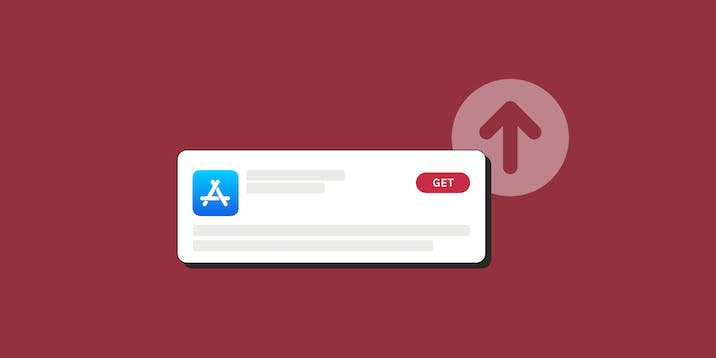
 Emily Sugrue
Emily Sugrue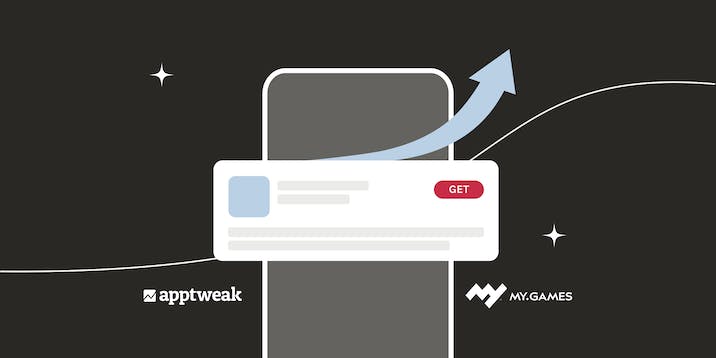
 Mariia Chernoplyokova
Mariia Chernoplyokova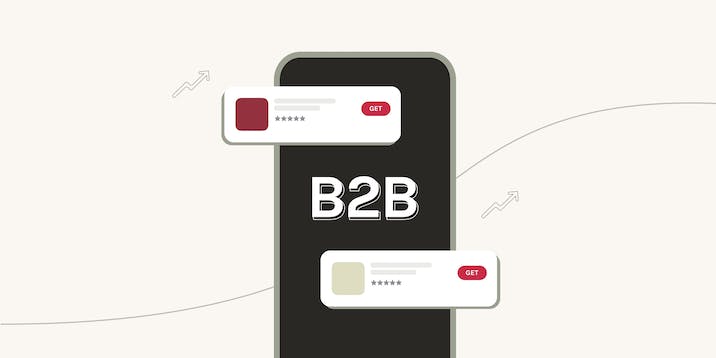
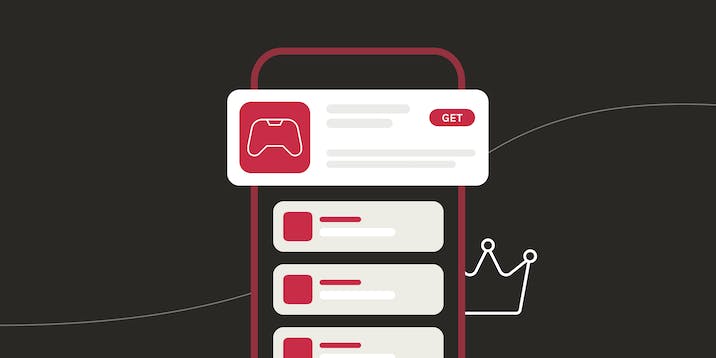

 Sarah B. Touimi
Sarah B. Touimi
 Yuliya Tsimokhava
Yuliya Tsimokhava